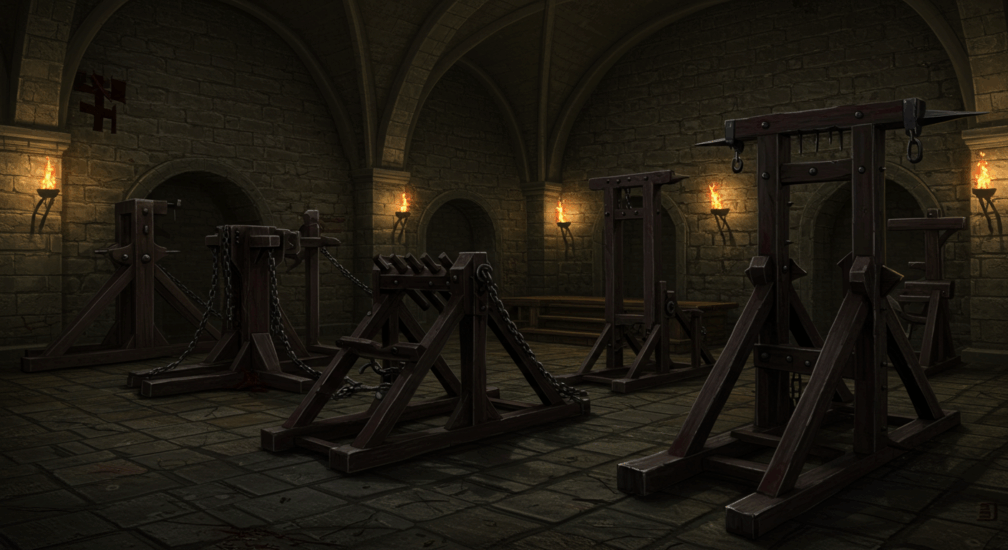The medieval period is often remembered for knights, grand castles, and epic battles. Yet beneath those romanticized images lurked a shadowy realm where medieval torture devices served as instruments of cruelty. The dark history of torture is a testament to humanity’s capacity for both invention and oppression. Over time, what began as rudimentary tools of punishment evolved into far more sophisticated methods of inflicting pain. Through these refined instruments of medieval torture, society witnessed the chilling intersection of technological progress in punishment devices and the deliberate desire to maximize anguish.
Early civilizations had already experimented with various forms of torment, but the Middle Ages took such designs to disturbing new heights. The refinement of medieval torture devices was driven by social demands for confessions, retribution, and intimidation. Rulers recognized that pain and fear could become potent forces, reinforcing their authority through brutal public spectacles. Meanwhile, artisans, blacksmiths, and even scholars found themselves contributing ideas that shaped how torture devices were created. In a world where warfare spurred innovation, it was only natural that the same drive for better weaponry extended into the realm of legal punishment.
Technological innovation in punishment was not purely accidental. As new metals were discovered and forging techniques improved, the designs of medieval torture methods became even more fearsome. The Iron Maiden, for example, combined a coffin-like enclosure with internal spikes, while the Rack was modified with metal attachments that held limbs more securely. Many of these devices were built with the goal of intensifying torment. This period revealed how torture and technology could intersect, forging tools that inflicted unimaginable cruelty.
The Influence of Craftsmanship and Method
Better craftsmanship was one of the leading reasons torture devices and advancements continued to flourish. Local artisans who specialized in weaponry soon found a lucrative market in instruments of oppression. Skilled blacksmiths who could craft superior swords were equally capable of building the iron hinges, gears, and screws needed for more elaborate torture techniques in the Middle Ages. Innovations that once fueled the battlefield also found their way into dungeons and interrogation chambers.
These new methods introduced a level of calculated suffering. Instead of inflicting immediate death, many devices were designed to prolong life and thereby prolong the pain. The technology behind such devices was a product of purposeful experimentation. When we speak of the impact of technology on torture devices, we are referencing not just the forging of metal but also the application of mechanical advantage, pulleys, and levers. All of this increased the torment while ensuring the victim remained conscious for extended periods. This marriage of brutality and design underscores the moral decay of the era, where justice was sometimes overshadowed by spectacle.
From Simple Tools to Complex Mechanisms
The history of torture devices traces a clear trajectory from basic hand tools, such as whips and clubs, to elaborate contraptions that combined steel, wood, and human ingenuity. One could argue that the invention of torture instruments mirrored the broader trends in technology. As mechanization improved, so did the ability to systematically apply pressure, tear flesh, or stretch limbs. Devices like the Head Crusher or the Scavenger’s Daughter used tightening screws to achieve excruciating effects. This refinement of medieval torture devices did not happen overnight; it evolved over centuries as blacksmiths and interrogators collaborated to enhance each iteration.
Ironically, the same period saw architectural marvels like Gothic cathedrals rise to the heavens, emphasizing devotion and faith. Meanwhile, in the dark recesses of castles, crueler designs were forged. The race for better methods of physical coercion remained ongoing, and knowledge about these contraptions spread via travelers, mercenaries, and even scholarly texts. In short, each generation found new ways to innovate, whether for war or punishment.
Public Display and Cultural Impact
The medieval age saw torture become not just a hidden practice but also a public spectacle. In places like town squares, these refined instruments of medieval torture would be demonstrated on accused criminals to serve as a warning. Spectators observed the cruelty and execution of harsh sentences with a mixture of fascination and dread. This approach, fueled by fear, helped maintain social order in an era often fraught with rebellion and unrest. The presence of advanced contraptions also meant that ruling classes could reinforce their power more effectively.
Yet such brutality also fostered a sense of collective torment. The populace witnessed punishments that sometimes bordered on performance art. As a result, an undercurrent of repression defined the period, shaping how communities viewed both justice and suffering. Over time, the weight of these displays led to questions about the moral foundation of such cruelty. Even so, the thirst for new contraptions did not abate until the modern era.
Spread of Knowledge and the Role of Travel
One surprising reason behind the technological advancements in torture was the constant exchange of ideas across regions. As explorers, merchants, and soldiers journeyed far from their homelands, they encountered foreign torture devices and brought this knowledge back with them. Exposure to different cultures introduced fresh concepts and designs, accelerating how torture devices were created locally. In port cities, blacksmiths occasionally collaborated to learn novel forging methods that provided stronger metal frames or more intricate gear systems for these instruments.
Interestingly, this was not limited to Europe. Although medieval torture methods are often associated with European castles and dungeons, similar developments occurred in various parts of Asia, the Middle East, and even the Americas. Culture, warfare, and the ambition to dominate others all played a part in the global spread of such ideas. The Middle Ages, for all their political fragmentation, were ironically interconnected by trade and movement of people, inadvertently fueling the invention of torture instruments.
Gradual Shifts in Attitude
Despite the widespread acceptance of medieval torture devices, voices of dissent did exist. Moral philosophers, theologians, and certain rulers questioned the justification of such cruelty, deeming it a possible affront to both ethics and religion. However, these criticisms were often overshadowed by the pressing demands for confessions and the perceived need to maintain order. Still, over time, the concept of more “humane” punishment began to take shape. The refining of torture devices indirectly prompted a reflection on the boundaries of suffering and the meaning of justice.
Public outcry occasionally surfaced, particularly after especially gruesome executions. In some cases, the very spectacle that was meant to instill fear instead sowed seeds of doubt. This moral tension set the stage for later periods, where legislative reforms sought to limit and eventually abolish many methods of judicial torture. But the seeds of all these changes were planted in the Middle Ages, when observers could see the extremes of torment in plain sight.
Modern Reflections on a Dark Legacy
In today’s world, these medieval torture methods hold a grim fascination for historians, researchers, and the curious public. Many people continue to explore the history of torture devices as a way to understand human psychology and the depths of cruelty societies can sink to. Museums dedicated to this subject now appear in different cities, each showing how technological advancements in torture coexisted with cultural and political needs of their time.
For anyone intrigued by the authenticity of these artifacts, the Medieval Torture Museum in Chicago offers a detailed look at how these implements were designed and used. Similarly, the Medieval Torture Museum in Los Angeles provides a mesmerizing collection of exhibits that reveal the synergy between torture and technology.
When planning a historical trip, some enthusiasts wonder where to visit in St. Augustine. That question is answered here, where travelers can witness a unique museum experience that delves into the dark corners of medieval punishment and torment. Should you wish to read more, there is an extensive blog that covers numerous aspects of brutality, invention, and legal frameworks that shaped the grim practices of the past.
Looking back, it is clear that technology influenced more than just warfare or agriculture; it shaped methods of oppression and pain. The impact of technology on torture devices evolved gradually, fueled by ambition, conflict, and the twisted fascination with perfecting the art of punishment. Each refinement was driven by a purposeful search for better leverage, sturdier materials, or more efficient ways to induce suffering. Though these instruments were intended for suppression, they also reveal how deeply entwined invention and cruelty can become when human empathy recedes.
Ultimately, torture techniques in the Middle Ages were not the product of random cruelty alone. They arose from a combination of social demand, political pressure, and the unstoppable march of mechanical innovation. The result was a series of gruesome tools that capitalized on advanced forging methods and cunning designs, ensuring prolonged torment. Moreover, these developments exposed the moral contradictions of societies that could build cathedrals to celebrate hope one moment and engineer brutal contraptions of anguish the next.
Reflecting on the Past, Learning for the Future
While modern societies have largely condemned judicial torture, echoes of those horrors remain in collective memory. The evolution and refinement of medieval torture devices serve as cautionary tales about what happens when power and fear coalesce. We recognize these chapters for what they are: examples of how torture devices were created with an almost scientific diligence, capitalizing on each new advancement to heighten despair.
Nevertheless, human history marches on. By examining the invention of torture instruments and acknowledging the dark history of torture in its entirety, we confront uncomfortable truths about ourselves. That confrontation allows us to remain vigilant in ensuring that these methods of torment never regain a foothold. From the vantage point of the 21st century, it is both sobering and revealing to see how far the refinement of pain could go when guided by the unrestrained hand of technological progress.
In the end, the merger of pain and tools, along with unwavering creative drive, exemplifies a cautionary thread woven throughout our past. The medieval world displayed that synergy in stark detail, leaving modern audiences to question how technology may be misused again if tempered neither by ethics nor compassion. By understanding torture devices and advancements, we take a small yet significant step toward ensuring that justice never returns to the realm of raw cruelty.






